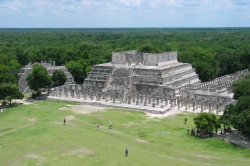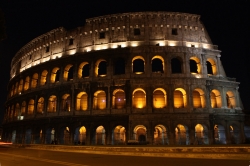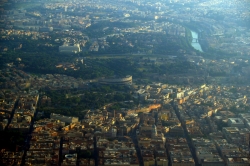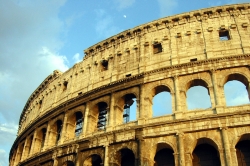Tourism can be an adventure of a lifetime, use Famous Wonders
as a travel guide to find the top travel destinations to visit and plan
your next great vacation trip. Famous Wonders contains a collection of
pictures and information about the world’s wonders and many famous
landmarks from popular cities around the world. Planning to travel and
do sightseeing? Browse through the top 100 wonders of the world or
navigate through the site to find the best tourist attractions by
country & cities. Where will you go next?
The Great Wall of China, a memorable landmark, is the most popular tourist attraction in China. The Wall has fascinated the minds of many in the world and it is part of the Seven Wonders of the World. The Great Wall is the ultimate tourist destination for sightseeing. People from all over the world visit China to see this exotic architecture because it is one of the most appealing attractions of China. It has its share of fans including those who spread speculations about it being seen from the moon.
Why, When, and Who Built The Great Wall?
Looking down at the Great Wall from the sky is truly amazing, the Wall resembles a Chinese dragon circling the mountains. There is a common term use by The Chinese call “Wan Li Chang Cheng” which defines as “Wall of 10,000 Li” (10,000 Li = 5,000 km). There were three main Chinese dynasties that contributed to the construction of the Great Wall: first, the Qin from 221-207 B.C., then the Han from 206 B.C – 220 A.D and the Ming from 1368-1644 A.D. Their common purpose was to stop the “barbaric” Huns in the North from invading the Chinese borders. Millions of people labored on the Great Wall and many died while working.
How Long is The Great Wall?
After the Qin emperor unified China, he connected the walls across the country into one, The Wall extended up to 10,000 Li (5000 km) and it helps keep out intruders from the north. What seems to be a Chinese zigzag dragon, the Great Wall of China spreads across deserts, rivers, mountains, grasslands and plateaus expanding nearly 6,700 kilometers. It has been built for over 2 millenniums and it stretches from the east side to the west side of China. Due to modern technologies and lack of usefulness, pieces of the structure are left in ruins and the Chinese leaders do not care to fix it. This marvelous segment of Chinese heritage swept through Shanhaiguan Pass, then to Liaoning, then Hebei, continuing onto Tianjin, expanding to Beijing, reaching Shanxi, and into Inner Mongolia, next to Ningxia, arriving at Gansu and finally ends in Jiayuguan Pass. The Great Wall length measures about 6,700 km long. Height wise, it is 4.5m to 9m. Depth wise, it is 4.5m to 8m. The entire structure was built by hand using stone, bricks, soil, sand, straw, wood, clay or whatever was available depending on the territory and time period.
The Great Wall Today
The existing Wall today was constructed by the Ming Dynasty over 600 years ago. During that time, the original wall was in ruins. Ming emperors order to rebuilt the wall over the course of 200 years. The reason the wall still stand today is because there was an invention during that time, mixing rice flour to create extremely tough bricks and mortar. Today, few parts of the Great Wall are in great condition because it was restored to attract tourists.
Petra represents the ancient world’s heritage culture. It is a beauty hidden behind layers of mountain. The ones who have seen it say it is a treasure beyond comparison. It is now said to be one of the seventh wonder of the world and it belongs to the UNESCO world heritage site. The entire red rose city of Petra has such a charismatic appeal that it attracts anyone & everyone who enters the city, taking them to a different world of divine beauty and mystery. Petra mainly is admired because of its picture perfect architecture, its complex structure, quality and the non mentionable mere size.
Petra is said to have its origin before 106 AD; its culture is said to have been flourished in almost 400 years old. The one’s who visited it say that it is a site that can never be forgotten. The city of Petra takes its name, which is the Greek word for “rock”, from the fact that it is most notable for its buildings and tombs that are carved directly into the red sandstone that serves as the city’s natural protection from invaders. Its popularity with tourists may also have a connection to the city’s Biblical significance. It is here where King Aretas called for the arrest of the Apostle Paul at the time of his conversion.
Location & How to Get to Petra
This historical fortress is located 170 miles southwest of Amman, Jordan on the edges of the Wadi Araba desert. It is also 50 miles south of the Dead Sea and the only way to enter the city is through a narrow crevice called the Siq. One has to uncover a very narrow path of mountains, kilometer by kilometer before they get to see the majestic beauty of Petra.This path is only about five meters wide, with sandstone walls towering up hundreds of meters high on both sides. This long, narrow & not very well lighted gorge is very cool & soothes the visitors before it unfolds the mystery step by step.
A taxi is the best means of transportation to get from the Queen Alia International Airport to Amman. Remember to ask the driver to take you to the Wahdat bus terminal, since there are two major bus stations in Amman. Destinations are usually printed in Arabic on the respective buses, so if you do not read Arabic, ask to be shown to the bus that will take you to Petra
.
The Taj Mahal is a tomb situated in Agra, India. The Taj Mahal was built by the Mughal emperor, Shah Jahan in the memory of his beloved wife, Mumtaz Mahal. The Taj Mahal is one of The Seven Wonders of the World and is said to be one of the finest art of the Mughal architecture. The architecture has a mixture of Persian, Ottoman, India and Islamic art. During the year 1983, the Taj became a part of the UNESCO, World heritage Site.
Some of the legendary stories say that after the Taj was built, the Mughal Emperor cut off the hands of all the men who built the Taj so that the same masterpiece could not be made again. The Taj Mahal is located on the banks of the river Yamuna in Agra. It was built in the year 1631 and got completed in the year 1653 spreading over 32 acres of land.
The Taj Mahal is also called the Taj and is a symbol of love and is known for its monumental beauty. Taj is one of the main tourist’s hotspot in India and anyone who comes to visit India definitely takes a tour of the Taj. The beauty of the Taj goes beyond words and it is said that the place looks magnificent during the full moon night. It is a true dedication to love and romance. The word Taj Mahal means Crown Palace in English and it is made up off mainly white marbles and some colorful gemstones.
The site predominantly contains many buildings of stone in various stages of thier preservation and has been stored properly. The site is built in different architectural styles. It has a very clear cultural mix and difference of the Mayan and non Mayan civilization. The Chichen site has in total three divisions: the north, central & and the south group. Where one group is in the Toltec style and the other gives an idea about the early period and the old Chichen culture. Since this is the most famous Mayan Pyramids, it has been thoroughly researched by private agencies. Not really.
It is now a federal property and it is maintained by the Mexico’s nation Institute of Anthropology and History. The best time for site seeing is either early morning or late in the afternoon.
Pictures & Photos
 Main Temple at Chichen Itza
Main Temple at Chichen Itza
Photo by: Celso Flores
 Mayan Architect at Chichen Itza
Mayan Architect at Chichen Itza
Photo by: Esparta
 Temple of the Warriors (Templo de los Guerreros)
Temple of the Warriors (Templo de los Guerreros)
Photo by: Wikipedia
Built in the center of Rome itself, its construction began sometime between 70 and 72 AD and was completed in 80 AD when Titus was the ruling emperor. It has a seating capacity of 50,000 spectators. The Colosseum over the years has been broken by natural disasters like earthquake; even then, it is one of the hot spot of tourist visits in Rome. Very near to the Colosseum is the training school for the gladiators and it is worth the look. As compared to the oval shape of the Colosseum, it is triangular in shape. Other areas of attraction are places where the armor was built, then where the wounded gladiators were cured and not to forget the burial ground where the dead gladiators rested in peace.
Today, the Colosseum is used for religious purposes. The Pope leads a procession on good Fridays called the station of the cross. Currently, the Amphitheater is very rich in Flora. There are more then hundreds of different kinds of Flora present on the ancient walls of the Colosseum. The Colosseum of Rome has been given great importance by the media and that is the reason why a lot of Hollywood movies have been shot in this amphitheater. The famous movie “Gladiator” is highly influenced by the Roman culture and the gladiator contests.
Traveling to the Colosseum
The fascinating history that involves bloodbaths and battles
associated with the structure is what draws visitors to this historical
site. Getting to the Colosseum by taxi or bus from the airport is easy
enough, but the line to get into the site itself can be excruciatingly
long, especially during the very busy summer season. Aside from going
there at any other time, there are other ways to get around these long
lines. You can buy your ticket either at the Roman Forum or the Via de
San Gregorio (these ticket counters are usually line-free), or you can
even get them online. You can also buy a combo ticket that covers
several of Rome’s main attractions, or call the office to reserve your
ticket in advance. Another good way to avoid long lines at the Colosseum
entrance is by joining a tour group.
 Direct View at the Colosseum of Rome
Direct View at the Colosseum of Rome
Photo by: ∞ Jacopo ∞
 Sky View of Rome and the Colesseum Lying in the Center
Sky View of Rome and the Colesseum Lying in the Center
Photo by: seier+seier+seier
 Original Facade of the Colosseum
Original Facade of the Colosseum
Photo by: Wikipedia
Great Wall of China
The Great Wall of China, a memorable landmark, is the most popular tourist attraction in China. The Wall has fascinated the minds of many in the world and it is part of the Seven Wonders of the World. The Great Wall is the ultimate tourist destination for sightseeing. People from all over the world visit China to see this exotic architecture because it is one of the most appealing attractions of China. It has its share of fans including those who spread speculations about it being seen from the moon.
Why, When, and Who Built The Great Wall?
Looking down at the Great Wall from the sky is truly amazing, the Wall resembles a Chinese dragon circling the mountains. There is a common term use by The Chinese call “Wan Li Chang Cheng” which defines as “Wall of 10,000 Li” (10,000 Li = 5,000 km). There were three main Chinese dynasties that contributed to the construction of the Great Wall: first, the Qin from 221-207 B.C., then the Han from 206 B.C – 220 A.D and the Ming from 1368-1644 A.D. Their common purpose was to stop the “barbaric” Huns in the North from invading the Chinese borders. Millions of people labored on the Great Wall and many died while working.
How Long is The Great Wall?
After the Qin emperor unified China, he connected the walls across the country into one, The Wall extended up to 10,000 Li (5000 km) and it helps keep out intruders from the north. What seems to be a Chinese zigzag dragon, the Great Wall of China spreads across deserts, rivers, mountains, grasslands and plateaus expanding nearly 6,700 kilometers. It has been built for over 2 millenniums and it stretches from the east side to the west side of China. Due to modern technologies and lack of usefulness, pieces of the structure are left in ruins and the Chinese leaders do not care to fix it. This marvelous segment of Chinese heritage swept through Shanhaiguan Pass, then to Liaoning, then Hebei, continuing onto Tianjin, expanding to Beijing, reaching Shanxi, and into Inner Mongolia, next to Ningxia, arriving at Gansu and finally ends in Jiayuguan Pass. The Great Wall length measures about 6,700 km long. Height wise, it is 4.5m to 9m. Depth wise, it is 4.5m to 8m. The entire structure was built by hand using stone, bricks, soil, sand, straw, wood, clay or whatever was available depending on the territory and time period.
The Great Wall Today
The existing Wall today was constructed by the Ming Dynasty over 600 years ago. During that time, the original wall was in ruins. Ming emperors order to rebuilt the wall over the course of 200 years. The reason the wall still stand today is because there was an invention during that time, mixing rice flour to create extremely tough bricks and mortar. Today, few parts of the Great Wall are in great condition because it was restored to attract tourists.
Petra in the Arabah
Petra is a site in the Arabah, Jordan that was discovered by a Swiss explorer called Johann Ludwig Burckhardt in 1812 and is considered to be, yet another splendid beauty in the history of mankind. Arabah is a section of the Great Rift Valley and it is located between the Dead Sea (north) and the Gulf of Aqaba (south) forming part of the border between Jordan (east) and Israel (west).Petra represents the ancient world’s heritage culture. It is a beauty hidden behind layers of mountain. The ones who have seen it say it is a treasure beyond comparison. It is now said to be one of the seventh wonder of the world and it belongs to the UNESCO world heritage site. The entire red rose city of Petra has such a charismatic appeal that it attracts anyone & everyone who enters the city, taking them to a different world of divine beauty and mystery. Petra mainly is admired because of its picture perfect architecture, its complex structure, quality and the non mentionable mere size.
Petra is said to have its origin before 106 AD; its culture is said to have been flourished in almost 400 years old. The one’s who visited it say that it is a site that can never be forgotten. The city of Petra takes its name, which is the Greek word for “rock”, from the fact that it is most notable for its buildings and tombs that are carved directly into the red sandstone that serves as the city’s natural protection from invaders. Its popularity with tourists may also have a connection to the city’s Biblical significance. It is here where King Aretas called for the arrest of the Apostle Paul at the time of his conversion.
Location & How to Get to Petra
This historical fortress is located 170 miles southwest of Amman, Jordan on the edges of the Wadi Araba desert. It is also 50 miles south of the Dead Sea and the only way to enter the city is through a narrow crevice called the Siq. One has to uncover a very narrow path of mountains, kilometer by kilometer before they get to see the majestic beauty of Petra.This path is only about five meters wide, with sandstone walls towering up hundreds of meters high on both sides. This long, narrow & not very well lighted gorge is very cool & soothes the visitors before it unfolds the mystery step by step.
A taxi is the best means of transportation to get from the Queen Alia International Airport to Amman. Remember to ask the driver to take you to the Wahdat bus terminal, since there are two major bus stations in Amman. Destinations are usually printed in Arabic on the respective buses, so if you do not read Arabic, ask to be shown to the bus that will take you to Petra
.
Taj Mahal
The Taj Mahal is a tomb situated in Agra, India. The Taj Mahal was built by the Mughal emperor, Shah Jahan in the memory of his beloved wife, Mumtaz Mahal. The Taj Mahal is one of The Seven Wonders of the World and is said to be one of the finest art of the Mughal architecture. The architecture has a mixture of Persian, Ottoman, India and Islamic art. During the year 1983, the Taj became a part of the UNESCO, World heritage Site.
Some of the legendary stories say that after the Taj was built, the Mughal Emperor cut off the hands of all the men who built the Taj so that the same masterpiece could not be made again. The Taj Mahal is located on the banks of the river Yamuna in Agra. It was built in the year 1631 and got completed in the year 1653 spreading over 32 acres of land.
The Taj Mahal is also called the Taj and is a symbol of love and is known for its monumental beauty. Taj is one of the main tourist’s hotspot in India and anyone who comes to visit India definitely takes a tour of the Taj. The beauty of the Taj goes beyond words and it is said that the place looks magnificent during the full moon night. It is a true dedication to love and romance. The word Taj Mahal means Crown Palace in English and it is made up off mainly white marbles and some colorful gemstones.
Chichen Itza in Yucatan Peninsula
Chichen was founded by the Maya civilization in 400 AD and it is located in the north central, north of Yucatan Peninsula now called Mexico. Chichen has a history that is 1500 years old and is located 75 miles from Merida. It is said to have been the main regional point for different ceremonies. During the earlier days & time, it was governed by priests. Chichen means “At the mouth of the well of Itza”. The word Chi stands for ‘mouth’, Chen for ‘well’ and Itza for ‘the Itza tribe’. The main belief is that people were thrown from the top as a sacrifice to make their god happy and the ones who could survive were the ones who were believed to be seers.The site predominantly contains many buildings of stone in various stages of thier preservation and has been stored properly. The site is built in different architectural styles. It has a very clear cultural mix and difference of the Mayan and non Mayan civilization. The Chichen site has in total three divisions: the north, central & and the south group. Where one group is in the Toltec style and the other gives an idea about the early period and the old Chichen culture. Since this is the most famous Mayan Pyramids, it has been thoroughly researched by private agencies. Not really.
It is now a federal property and it is maintained by the Mexico’s nation Institute of Anthropology and History. The best time for site seeing is either early morning or late in the afternoon.
Pictures & Photos
 Main Temple at Chichen Itza
Main Temple at Chichen ItzaPhoto by: Celso Flores
 Mayan Architect at Chichen Itza
Mayan Architect at Chichen Itza Photo by: Esparta
 Temple of the Warriors (Templo de los Guerreros)
Temple of the Warriors (Templo de los Guerreros)Photo by: Wikipedia
Colosseum
The Colosseum is one of the greatest architecture ever built in the history of Rome. The Colosseum was originally known as the Flavian Amphitheatre and is the largest amphitheater to have ever been built in the Roman Empire. It is a circular structure that occupies a site east of the Roman Forum. This Amphitheater was built to organize gladiator contests, dramas and games like hunting animals, constructing mock sea battle and the public could also view it in the open, and cheer their favorites.Built in the center of Rome itself, its construction began sometime between 70 and 72 AD and was completed in 80 AD when Titus was the ruling emperor. It has a seating capacity of 50,000 spectators. The Colosseum over the years has been broken by natural disasters like earthquake; even then, it is one of the hot spot of tourist visits in Rome. Very near to the Colosseum is the training school for the gladiators and it is worth the look. As compared to the oval shape of the Colosseum, it is triangular in shape. Other areas of attraction are places where the armor was built, then where the wounded gladiators were cured and not to forget the burial ground where the dead gladiators rested in peace.
Today, the Colosseum is used for religious purposes. The Pope leads a procession on good Fridays called the station of the cross. Currently, the Amphitheater is very rich in Flora. There are more then hundreds of different kinds of Flora present on the ancient walls of the Colosseum. The Colosseum of Rome has been given great importance by the media and that is the reason why a lot of Hollywood movies have been shot in this amphitheater. The famous movie “Gladiator” is highly influenced by the Roman culture and the gladiator contests.
Traveling to the Colosseum
The fascinating history that involves bloodbaths and battles
associated with the structure is what draws visitors to this historical
site. Getting to the Colosseum by taxi or bus from the airport is easy
enough, but the line to get into the site itself can be excruciatingly
long, especially during the very busy summer season. Aside from going
there at any other time, there are other ways to get around these long
lines. You can buy your ticket either at the Roman Forum or the Via de
San Gregorio (these ticket counters are usually line-free), or you can
even get them online. You can also buy a combo ticket that covers
several of Rome’s main attractions, or call the office to reserve your
ticket in advance. Another good way to avoid long lines at the Colosseum
entrance is by joining a tour group.Pictures & Photos
 Direct View at the Colosseum of Rome
Direct View at the Colosseum of RomePhoto by: ∞ Jacopo ∞
 Sky View of Rome and the Colesseum Lying in the Center
Sky View of Rome and the Colesseum Lying in the CenterPhoto by: seier+seier+seier
 Original Facade of the Colosseum
Original Facade of the ColosseumPhoto by: Wikipedia




